Drawing Tablet Wont Draw Untill a Distince
Ergonomics of Graphics tablets
Published on

About the 2020 remake of this article: For the ten years anniversary of this article (originally published on April 11, 2010) I decided to rewrite it and refresh all the article. I also made new artworks and published them in higher quality. Over the years, I was super happy to see this article being republished on big CG portals, printed on CG magazines and even the artworks were republished by Wacom on their blog! Recently, I had the request for another repost; but after re-reading the article, I felt it to be totally obsolete and not really in sync with what I'm thinking now... Since 2010 many things happened: the first Ipad-like tablets with styluses, the historical monopoly of Wacom breached after their patent for battery-less stylus expired and competition could finally start on the tablet market with many new models (Huion/XpPen/etc...) and tablet computers with a pen are cheaper to buy and more and more common on the desk of artists. So, this update was more than necessary. I hope you'll enjoy reading it.
Intro
The perfect graphics tablet doesn't exist. But you'll eventually adapt to the weird specifications and ergonomics issues of your tablet model and make it perfect for you. This adaptation process made by your body (in regards of the ergonomics flaws of your hardware) will have an impact on your health in the long run. It might also affect your pleasure to draw and paint...
Since 2002, I have bought and used a lot of tablets to try to build the best setup I could. It came as a necessity to ease my full days of digital painting. Nowaday, my quest for the bests tablet still continues as the technology keeps evolving year after year. If you want to read more about what I used and why, read my maintained "Tablet history log" article, from 2002 to today. But beyond the choice of the hardware itself, I also studied other aspects about it. And the first one that comes to my mind is the ergonomics of my desktop position. So, let me share with you my experiences about ergonomics.
Disclaimer: I'm not a professional ergonomist, I'm not working in the health-care industry and I wrote this article from the humble point of view of a digital painter who happens to paint almost daily with digital graphics tablets since 2002. This article is just based on my personal experience, it contains all my bias and should be read as the testimony of a random artist on the internet. I wrote it and share it because I want to make it useful for other artists struggling with the same questions. This article doesn't have the seriousness of something like a scientifically tested study made on a large group with solid statistics. If you find a paper like that, please write it in the comments, I'll be the first one interested to read it.
General thoughts about other input devices
The keyboard
I guess I'm not the only CG artist that use a lot of keyboard shortcuts to speed up my work-flow. Vendors and designers of graphics tablets understood that clearly and started to add more and more buttons on their products to setup more custom shortcuts with easier access. Isn't this a sort of confession that graphic tablets are designed without thinking of a good access to the keyboard? But since a couple of years, tablets vendors have started to innovate into other directions and sometimes added tiny devices that look like remote controls (a), or just added more buttons (b), or removed all physical buttons and propose a virtual keyboard with touch interface (c). I'm not sure where the main tendency will go now.
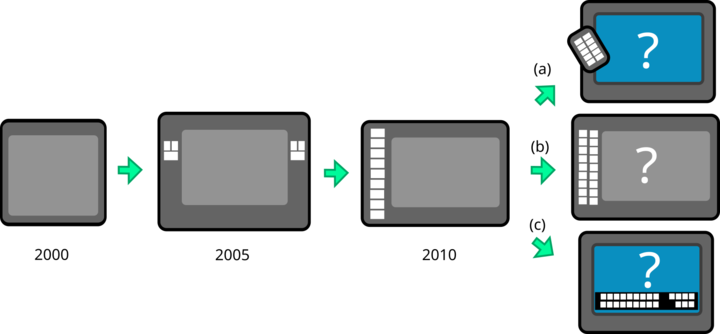 The evolution of buttons on tablets
The evolution of buttons on tablets
On their side, digital artists started to use additional devices at the side of their tablet: gamepads, one handed gaming keyboard, customisable keyboard. But even with this research for better accessibility of keyboard shortcuts, this set of additional keys and devices will never replace the flexibility and completeness of having a full keyboard under one hand in my humble point of view. It is especially easy to to experience if you like to chat while painting, write notes, reply to emails, add descriptions in your artwork or browse for references on the web while you are working. For all these tasks, you'll need a full keyboard.
Unfortunately, a large tablet (with a display built-in or not) tends to land on the desk at the exact place where the keyboard was used. So, there is a conflict; a competition between the two input devices that's really hard to solve. Vendors of tablets haven't put a lot of thought on this topic yet. The later part of this article will consider the importance of having good access to the keyboard for this reason.
The mouse
It is tempting to think graphics tablets can fully replace the role of a mouse. Sure they can. But for some workflows or games it is not always the case or the most convenient way to use the software. In many situations, a mouse will be more steady and precise and so the workflow will be faster using it. A lot of software is developed with the features of a classical mouse in mind (e.g. the mouse wheel and mouse wheel click to zoom/pan). That's why I think it is necessary to keep an extra mouse on the desk.
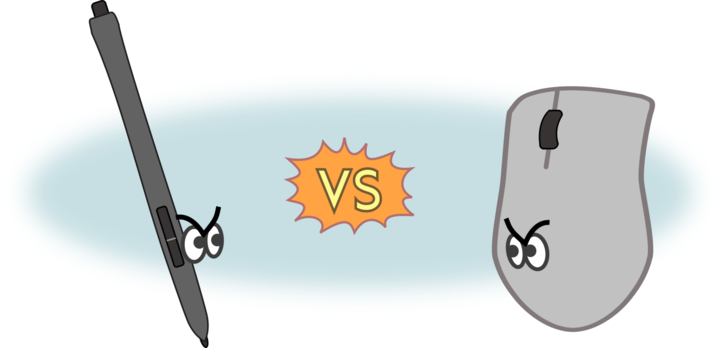 Stylus versus Mouse? And why not both.
Stylus versus Mouse? And why not both.
Note about old tablets: Before 2010 many tablets −as was the Wacom Graphire 3− had a mouse delivered in the package. This one was reacting only to the active surface of the tablet. This trend was abandoned and I understand why: this device had to be removed from the active surface area each time the user switched between the pen and the mouse. I had two models like that; the built-in mouse was never used in favor of a classic mouse connected to the system.
1. Large graphics tablets
Large classic graphics tablets (without a built-in monitor) are certainly the most precise and comfortable from a technical point of view. But the number of large classic models available is decreasing and disappearing on the market over the time. It's a shame because monitors went bigger for a cheaper price with the last five years and also got a lot more resolution. The same tendency should have been followed by the emergence of new large graphics tablets with high resolution. But it's not the case.
Around 2000, a "1024x768px 15inch CRT" display paired with a medium tablet was a good match. Nowaday, it would be hard to use the same size of tablet on one of our modern wide "FullHD 1920x1080px 21inch display" (and I'm not speaking about the 24inch, 27inch, quadHD, 4K resolution being more and more cheap and common). In this context, for modern users of PC on desktop with a large external monitor, adopting a large tablet makes sense to better control the pointer on the monitor. Indeed, if you draw a circle sized like a small coin on your small tablet and it displays a big sized balloon on your monitor you'll have a feeling of no control over painting details. You can imagine how you'll struggle to draw a little eye or a detail. It will always be possible but you'll have to zoom a lot to balance your hardware issues of precision.
But large tablets have also a lot of cons. The first one being their price and the second one is the room it will take on your desk.
a) Large tablet on the side
The first way people usually place their new large graphics tablet is on the side of their keyboard, as a mouse pad. This position stresses and hurts the arm and shoulder. But this position might be good enough if your main task is typing text and if you'll need the tablet only once or twice a day. I saw this position being used by the people convinced the graphics tablet should replace the mouse. Vendors of graphics tablets made commercial campaigns in the past to propose the tablet as the replacement of a healthier mouse. For the one with repeated stress injury because using too much a mouse, it can be indeed a good option. While visiting studios of 3D artists and video editors, I often saw this type of layout on desks. At the end of the day, I don't advice it unless you need a large tablet and have problems with mice.
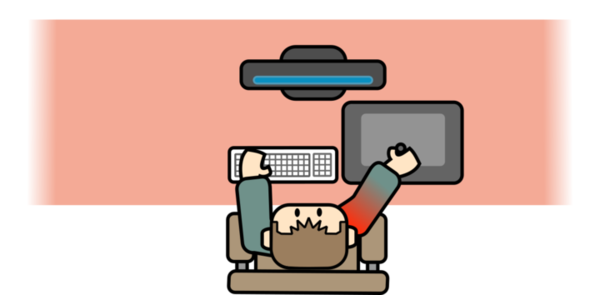
b) Large tablet centered
One solution is to put the graphics tablet at the center of the desk and use your keyboard on the left. Having the active surface of your tablet aligned this way to your display is also comfortable for your moves and increases your ability to paint for hours. But if you need to reach the keyboard too often, this layout can quickly become a pain. It will force you to twist your back to face the keyboard, even at a slight angle, and you'll do the same with the neck to counter balance and look at your monitor. Also many useful keyboard shortcuts (eg. Ctrl+Z, Ctrl, Ctrl+S, Shift) are located on the left part of the keyboard. I wouldn't advice a position like that either.
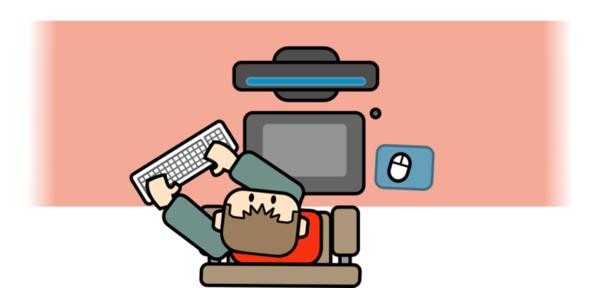
c) A trail for the keyboard (or keyboard on lap)
To keep the keyboard easy to reach, a reasonable solution is to adopt one of these trails you can screw under any type of desk (except if your desk is made of glass) to get a keyboard that can be accessed under the desk. The cheap alternative is to put the keyboard on your lap. I had this setup but I'm not a fan at all about this position to write on the keyboard.
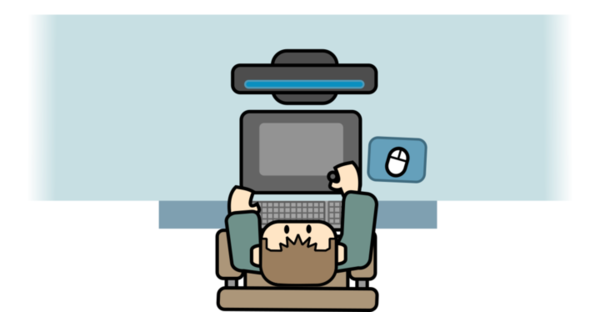
d) Curved desk
Adopting a curved desk with a chair able to rotate improves the situation a lot over (b). By mapping devices closely all around you, you won't be twisting your back or extending your arm too much. You'll even benefit from having a part of the desk to rest your arm on. I had this setup for a month while I was working at a studio and it was working really well. One of the problems with a curved desk is often they are big, deep and require an angle in your room. I can't get one at home for this reason.
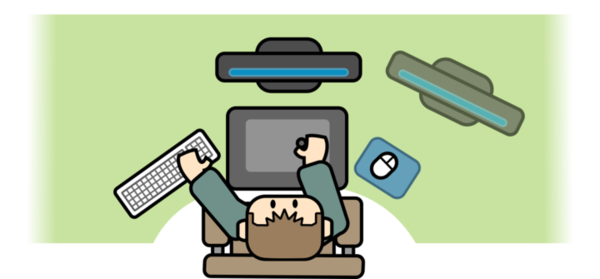
e) The keyboard up the tablet
My favorite layout and the one I've been using for years require a little bit of DIY. First, the monitor needs to float with one of these metal arms. This way you'll have room to place more things under the monitor (you won't be blocked by the stand of the monitor). For the typing/keyboard position: place your keyboard at the top of your tablet. To protect the fragile surface of your tablet from scratches you'll need to glue little sticky pads under your keyboard (usually made for putting under furniture, sold in DIY stores). The keyboard will glide more easily this way, too, switching between positions with just one movement. Then the last piece of the installation is to put a thick book or a plank of wood in front of your big graphics tablet, right under the display (not visible on the figure below, I forgot it). It will be an area for you to push the keyboard or to grab it when you need to type something. The keyboard will remain also accessible while painting for shortcuts.
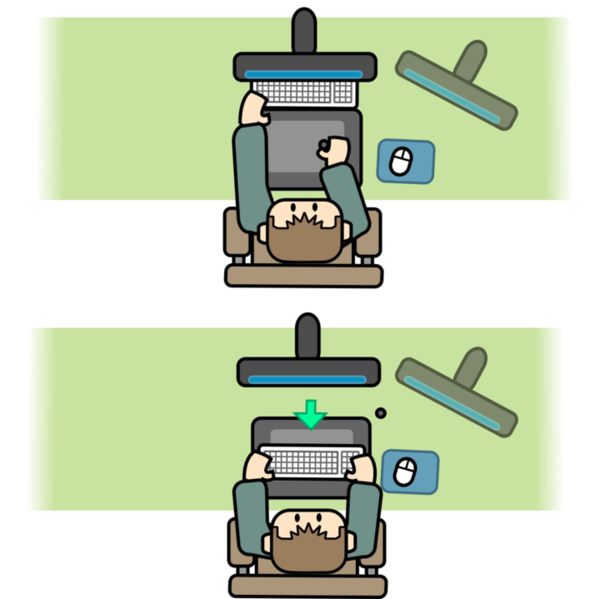
2. Small/Medium graphics tablets
These graphics tablets (still without a built-in monitor) have mainly smaller price and smaller active area. They are of course less precise than the larger tablets and the vendors of tablets often try many attractive designs and optimizations to create cheap products. That's why so many small/medium tablets exist on the market with a wide spectrum of quality and design. There are not more of them because they are better; just because they are much cheaper. They are often known to be the first tablets of every consumers (and many digital artists started this way, me included). On a desktop computer, ergonomics of small graphics tablet are usually better with this size than with larger tablets.
f) Angular axis
Here is how I prefer to use this size of graphics tablet: I angle my full body axis to the edge of the desk and get this way a large spot to put my elbow. It allows me to paint during longer periods this way. You can note that while it was problematic to keep a large tablet (a)(b) on the side of the keyboard it is no more a problem for a smaller tablet.
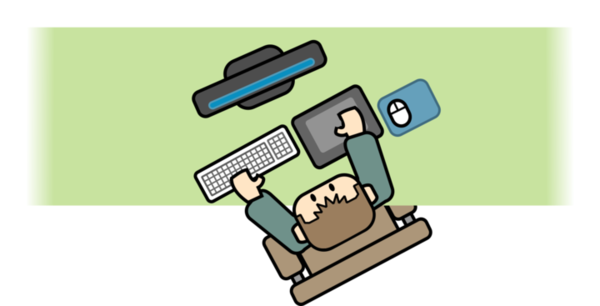
g) Curved desk
Here again as in (d), adopting a curved desk will improve a lot the ergonomics of your workspace.
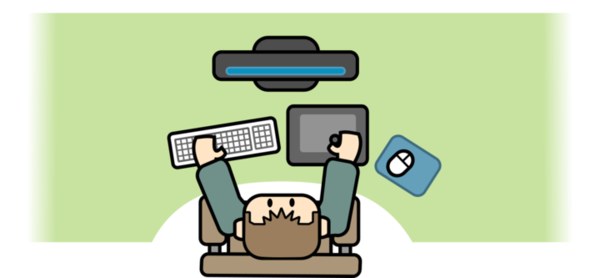
3. Laptop, mobility and travels
The users of graphics tablets often need to travel to another place to work. It means they often require a mobile way to work. This one can be on the transport, at the desk of a client, in front of a classroom or during a conference... For that, the vendors of graphic tablet often don't propose a lot of creativity. Only one innovation on the market really changed everything: tablets with built-in computer and display.
h) The impossible match
Using a laptop and large tablet is a hell and often doesn't work at all. I know it sounds obvious, but that's something to consider while buying a large tablet: it isn't really mobile-friendly.
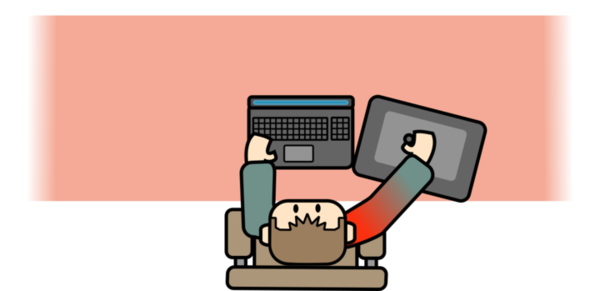
i) The small tablet flexibility
Working with a laptop and a small tablet is not that bad and can face a lot of situations. Small tablets are usually also sized under a A4/Letter size paper. This is great to make them compatible with many bags; offering a lot of possibility to travel with them.
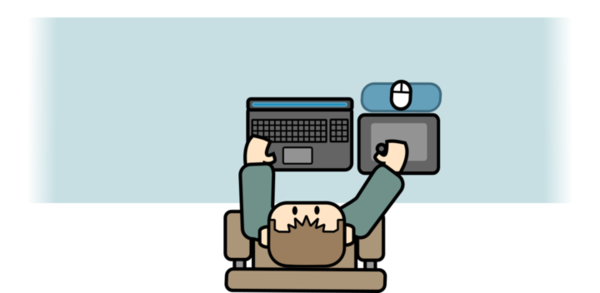
You can solve the pain by adopting a slight angle with the desk. I taught in classroom with a setup like that (when the desk had enough room) and I did a lot of public demo this way too.
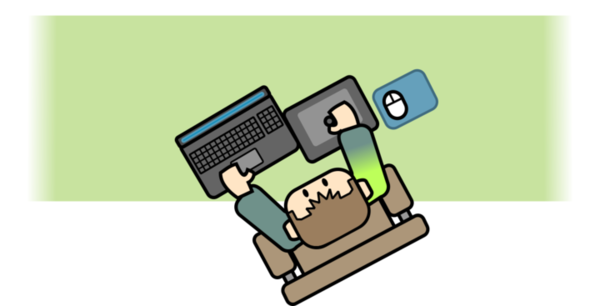
One layout I also enjoy is when I can cover the touch-pad of the laptop with the tablet and align it with the monitor.
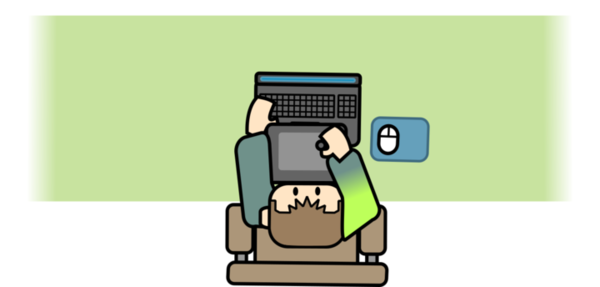
j) During travel
Little graphics tablets can be useful on a plane or a train. They are flexible to be used on this type of temporary and uncomfortable situation. But believe me, optimizing a long 5h train trip and completing a full artwork on the way feels very rewarding.
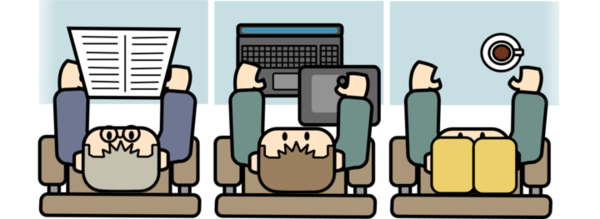
This way to work above is hopefully something soon of the past. Many touch tablet with styluses have appeared on the market and offer much better ergonomics.
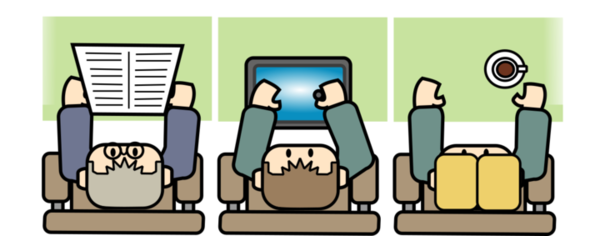
I'm rarely excited by these devices because I dislike all mobile operating systems in general and I dislike typing on touch devices. But maybe my feelings will change with the progress done by the technology. I'm hating less and less using my phone, so maybe the user experience will improve? Meanwhile, if you have the room for it, I still would advice for using them with an external keyboard.
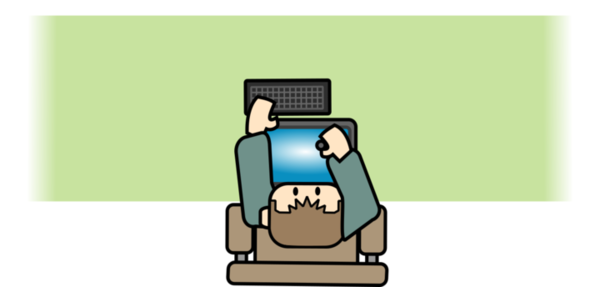
4. Large graphics tablets with display
The big models of pen tablets with display all have in common big ergonomics issues. I owned or tested also a lot of tablets with a display over the years and the while the technology hasn't changed a lot for the classic graphics tablets; the specifications of the graphics tablets with a display changed a lot over the years (thanks to the monitor, phone and tablet industries. I remember the first Ipad was released in 2010...). These graphics tablets allows working directly on the surface and the sync is better between the hands and the eyes. It allows to do gesture drawing more easily and get more precision for line-art and drawing.
The large tablets with a display first appeared on the market as very expensive devices. Nowadays their their price is only a third of what it was around 2005. The problems of these devices: parallax (distance between the tip of your stylus and what appears on the screen), hand might get warm on some area of the devices leading to sticky hands and having to wear a glove (a side effect of having an electric monitor under the palm), the surface of the tablet is rarely able to offer a good texture (vendors and designers often have to choose between getting a slightly blurry but textured feeling for the stylus or a crystal, too smooth, clear glass for the display), the surface is fragile (dirt trapped between the stylus and the surface can scratch it) and it's harder and more expensive to replace the overlay-sheet on a display tablet than on a classic tablet.
k) A surface tilted: a three dimensional issue
The surface of the tablet will always be tilted like an easel: it's rare to get a big model flat enough to use it as you would for a large sheet of paper, flat on the desk. So, you have to use the built-in stand provided with the tablet, designed often for being used in only two main positions: an easel one with more or less angle (but starting always too high on your desk compared to the thickness of a sketchbook) and a vertical-like position to use the tablet as a monitor. This angle increase the difficulty to access to a keyboard on the side; so it is useless to place a keyboard this way.
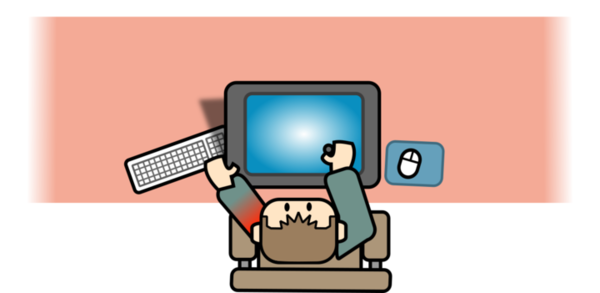
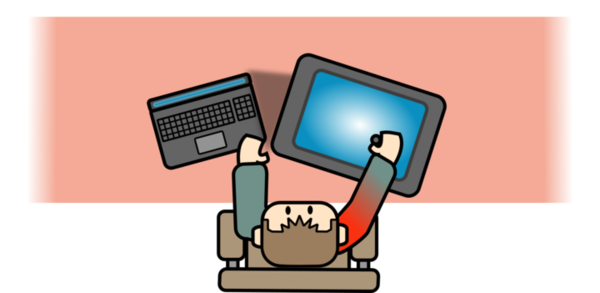
l) Keyboard on top
Because the surface is tilted, you can't put the keyboard over the surface. You'll have to buy a dedicated rigg for that (in orange on the figure below). Companies propose this but it's never proposed by the vendors of tablets themselves while I think a built-in solution part of the big display tablet designed for that would be great.
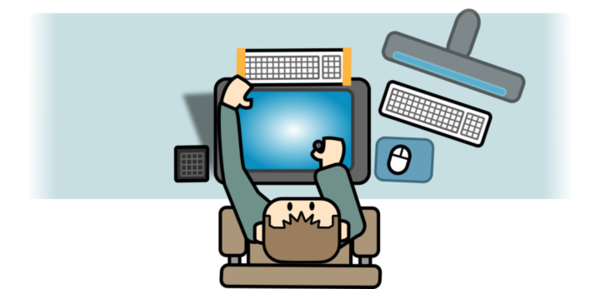
m) Keyboard under it
Placing the keyboard on your lap −often meaning under the desk− is one bad possibility as it will put more distance between you and the surface. Putting the keyboard under is another variation about it that might work.
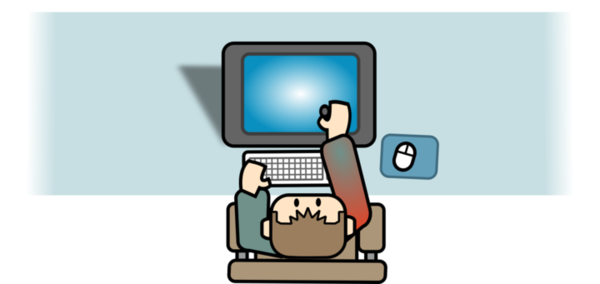
n) The dual position
With a chair having wheels it is possible to use a large pen display connected to a computer having already a keyboard and a small graphics tablet. This way, you keep the large pen display for just the long hour of painting.
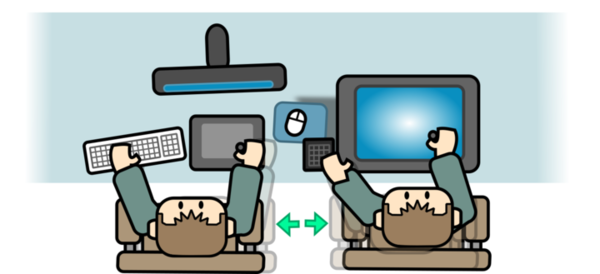
o) The big DIY
One of the best ways to use a large pen tablet is to cut a hole on the desk (a drawing table) and merge the surface of it on the table/desk. This is a rare setup, but one I saw among many professional manga artist. You 'll see in this video in Japanese by artist Yoshikadu the step by step of making a complex rig like that. Impressive!
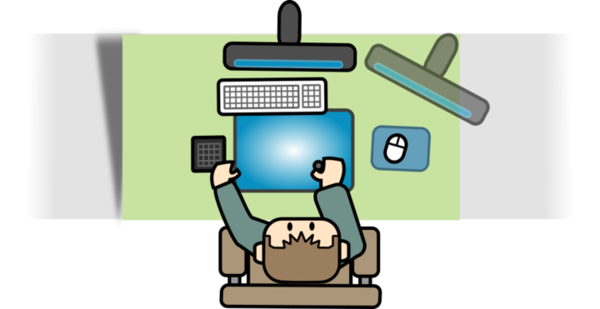
Note about touch devices: I never tried the very large pen tablet displays with 'touch' on screen virtual keyboard. My feeling are mixed about them; while I see how it could solve many ergonomics issues by having a keyboard around a corner of your screen, I'm still not fond of typing or gaming on touch keyboards and I find this on-screen-display still inferior to real buttons...
5. Small graphics tablets with display
Small graphics tablets with a display are usually cheaper than the larger models but also more flat; and this detail changes a lot of things because you can use them as you would with a sketchbook or a sheet of paper on your desk. They often can be used as well with an external monitor and mimic a classic graphics tablet. This hybrid setup often offers the best of both worlds when managed correctly.
p) The hybrid setup
The small graphics tablets with a display often already have the size of a "large classic tablet" (without display). A 13inch or 15, 16inch might be as large as a Large classic model. By using them with the picture on the monitor cloned to the main display, it's possible to get a hybrid workflow. Using the tablet and keyboard ergonomics of a classic large tablet and get the bonus of having the possibility to look at the tablet for more precise drawings.
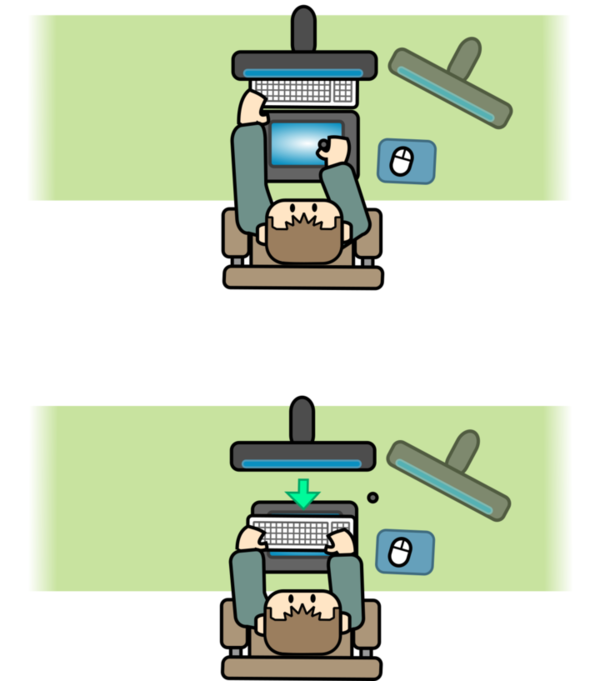
Conclusion
As I said in the intro, the perfect graphics tablet doesn't exist and your best chance to find the one that suits your body and lifestyle may well be to try a lot of them. But also I want to insist that we all have bodies and habits that can adapt: a not so comfortable tablet, too smooth, too large, might become your best hardware and best tool if you do the effort to commit at painting hours and hours on it. I also work this way.
So, if you already own a tablet, take care of it, whatever model it is; it can produce your next masterpiece. Just understand it, and just with what you find around yourself and a bit of DIY you can already build and optimize a better environment to enjoy your painting time longer. I hope this article inspired you to take care a bit more of your work position and think about it more. If you want to share your experience and continue discussing about this, you'll be welcome in the comments section on the bottom of the page.
Foot notes:
- All artwork (Inkscape source for the asset) examples were drawn with a male figure, right-handed. It wasn't designed to exclude all other genders and left-handed artists, I'm sure you'll get it and understand how to adapt this example to your situation.
- As I'm French, my English is far to be good enough to write an article like that. If you notice some mistakes and want to contribute to make it better, feel free to grab the source file of this article (link under, markdown file) correct it, and send me back by email with your corrections.
Changelog:
- 2020-09-16: Proofreading pass, thanks Yorwba and Chris K.!
- 2020-09-13: For the ten years, refactor of the article (artworks and text).
- 2010-08-04: proofreading pass, thanks Slug45!
- 2010-04-11: Original release date of the article.
Drawing Tablet Wont Draw Untill a Distince
Source: https://www.davidrevoy.com/article30/ergonomics-of-graphics-tablets
0 Response to "Drawing Tablet Wont Draw Untill a Distince"
ارسال یک نظر